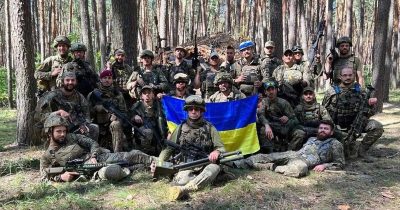“We are exhausted”: NYT Reveals Weakness and Exposes Casualties of Ukrainian Soldiers

All Global Research articles can be read in 51 languages by activating the Translate Website button below the author’s name (only available in desktop version).
To receive Global Research’s Daily Newsletter (selected articles), click here.
Click the share button above to email/forward this article to your friends and colleagues. Follow us on Instagram and Twitter and subscribe to our Telegram Channel. Feel free to repost and share widely Global Research articles.
New Year Donation Drive: Global Research Is Committed to the “Unspoken Truth”
***
Western media have not stopped reporting negative news about the performance of the Ukrainian military since the launch of its counteroffensive last summer, in which more than 90,000 Ukrainian soldiers were killed or injured. This time, The New York Times described the conditions in which Kiev’s troops operate, which have long suffered from a shortage of soldiers, making it extremely difficult to advance.
The outlet interviewed members of the 117th Separate Mechanized Brigade of Ukraine. One of them said, “Physically we are exhausted.” While they claimed that morale was high, they could not hide the deficiencies in their ranks.
“We are short of people,” said an intelligence commander of the 117th Brigade who uses the call sign, Banderas, supposedly after the actor Antonio Banderas, but this is likely a cover story, and he is instead probably named after Stepan Bandera, a World War II Ukrainian Nazi collaborator. “We have weapons but not enough men,” Banderas added.
Both officers and soldiers admitted to the American newspaper that “Russian attacks were so intense that operating near the frontline has never been so dangerous.”
“Soldiers said that since March they had suffered the additional devastating power of glide bombs, half-ton explosives unleashed from planes that smash through underground bunkers,” noted the newspaper.
“They would send them two by two by two, eight in an hour,” said a 27-year-old soldier of the 14th Chervona Kalyna National Guard Brigade, known as Kit. Like others interviewed, Kit identified himself by his call sign, according to military protocol. “It sounds like a jet coming down on you,” he said, “like hell’s gate.”
Kit told the New York Times that he believes the Kiev regime “should be doing more” to reinforce its arsenal of drones, a weapon that, according to him, Moscow uses effectively. He highlighted that, unlike Russia, Kiev still relies on civilian volunteers and donors for its drone program.
According to the newspaper, Russian forces use a type of “subterfuge” to play tapes of gunfire on drones and, in this way, make Ukrainian soldiers believe they are being attacked, leading them to abandon their bunkers and reveal their positions.
In addition, Ukrainian forces also deal with smoke grenades launched by Russian drones, which “causes a very strong pain in the eyes and a fire, like a piece of coal, in your throat, and you cannot breathe,” according to a Ukrainian soldier identified as Medic.
“The toll is heavy for all units along the front. Almost everyone has been wounded or survived a narrow escape in recent months,” soldiers said to the outlet.
The revelations made to the New York Times match recent reports from the front about the increasingly bleak picture for the Ukrainian military following the failure of last year’s counteroffensive, a new round of Russian missile and drone attacks, concerns that NATO may abandon Ukraine, and fears of the possibility of a Russian advance along the front.
Zelensky himself said that many of Ukrainians were no longer committed to the war. The exhaustion is felt by the soldiers, as revealed in the New York Times, but also by ordinary citizens and the West. Western political and military leaders recognise that there is no hope of regaining Ukraine’s lost territories, but Zelensky maintains the delusion to citizens that even Crimea could be captured.
The Russian and Ukrainian armies strive to stabilise the front and carry out strategic strikes, but this requires the appropriate capabilities. In this context, it is Russia showing its superiority in a war of attrition aimed at exhausting the morale and resources of Ukraine at a time when the country is becoming increasingly dependent on foreign support.
Ukraine’s deputy prime minister Mykhailo Fedorov told The Wall Street Journal in an article published on January 8, that Kiev has been using FPV drones instead of artillery because it does not have enough ammunition, with Ukrainian forces firing one or two shots for every five or six from the Russians.
The newspaper also completed an analysis of the strategic situation last week, showing that Russia’s military budget and weapons production capabilities have increased dramatically over the past two years. “Ukraine is also investing in domestic military production capabilities, but it is no match for a much larger Russian military-industrial complex running at full steam. Kiev could fall further behind as Western support dries up,” WSJ reported.
US and European officials have repeatedly warned that Ukraine’s military will fail against Russia without further cash injections from NATO allies, confirming Moscow’s characterisation of the Ukrainian crisis as a “proxy war” between Russia and the Western bloc. Whilst soldiers, society and Westerners are tired of fighting, Zelensky insists on continuing the futile war effort against Russia.
*
Note to readers: Please click the share button above. Follow us on Instagram and Twitter and subscribe to our Telegram Channel. Feel free to repost and share widely Global Research articles.
Ahmed Adel is a Cairo-based geopolitics and political economy researcher. He is a regular contributor to Global Research.
Featured image: Joining forces: The International Legion of Territorial Defense of Ukraine has enabled thousands of foreign volunteers to join the fight against the Russian invaders. Image: Mil.gov.ua / Wikimedia Commons

